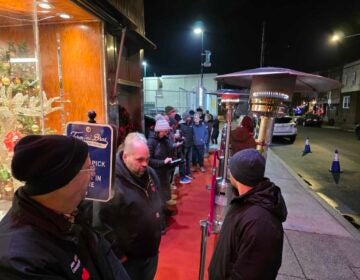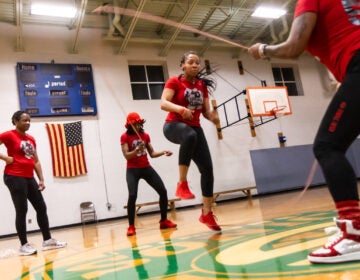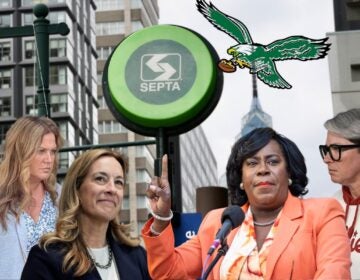Community garden proposal sprouts up in East Falls
In preparation for the spring planting season, an East Falls resident is laying the seeds for a new community garden.
Last week, Dale Rio held the first meeting of an initiative to bring a community garden back to the hillside neighborhood. It’s been almost a decade since the last such effort, and Rio believes the time is right to begin preparations. She’s looking for residents’ input and assistance.
“There are a million different ways a community garden can go,” she said. “It depends on the energy, the resources, and the people working on it.”
Site suggestions
First and foremost on Rio’s list is finding the right location. There are two ways this can take shape: A single, centralized community garden or a collection of smaller, decentralized gardens. In addition, there are partnerships with local schools to be considered.
Neighbors present at the meeting suggested two possible sites for a garden: One at the intersection of Ridge Avenue and Calumet Street in a vacant lot; the other in a lot at the intersection of Ridge Avenue and Scotts Lane.
Rio reported that the owner of the Calumet Street lot was amenable to the idea when presented in an earlier proposal; the Scotts Lane property is a larger site with potentially favorable usage terms.
However, Rio emphasized that she is just in the preliminary stages, and the further details about potential gardens will be dictated by the character of the space.
“We’re starting things now so that they’re firmly in place for spring planting season,” she said.
Adventures in horticulture
Rio, who originally moved to East Falls in March 2010, had never gardened before moving to Philadelphia.
Originally from Connecticut, she went to NYU for graduate school in photography and bounced back and forth between east and west coasts, ending up in Brooklyn, where her inaugural attempts at horticulture took place on a fire escape.
Since her arrival in Philadelphia, she became interested in permaculture, which is the use of nature as a template for the design of human environments, with an emphasis on sustainability.
There are practical components as well: In addition to learning the basics of food production and reinforcing self-reliance, it’s a means to reconnect with an ancient pursuit, much of which, Rio noted, has been lost in just a few generations’ time.
“Gardening used to be so much more widespread,” she observed.
Environmental, neighborhood and aesthetic advantages
Rio’s interest in community gardens was fostered in her studies with Melissa Miles, an environmental biologist who operates the Two Miles Micro-Farm at the Permanent Future Institute in Central Montgomery County.
Miles said there were several positives to neighborhood-based garden efforts, of which building a “foodshed” is an important component.
“Food production at present is not resilient,” she said, “so we need to relocalize in order to build resilience.” This process also leads to the localization of commerce, as small market gardens keep money within the community.
There are environmental impacts as well. In addition to providing more neighborhood green space, gardens mitigate stormwater runoff, augmenting efforts being undertaken by the Philadelphia Water Department. In addition, there’s an aesthetic benefit – “It’s much nicer to have a maintained garden than a vacant lot,” she observed.
Lastly, there’s the human dynamic. Community gardens bring people together, Miles said, thus building community and providing senses of cohesion and commonality.
But there are challenges: Management is an ongoing concern, and bringing a community garden into existence takes a lot of willpower and energy. Once established, however, problems are minimized.
Securing water sources are also an important consideration, as tapping into fire hydrants breeds ill-will among neighbors. The solution is a good design, said Miles, one that provides for the catchment and harvest of rainwater.
The end result is more than fresh vegetables.
“It empowers people, giving them control over their destiny,” Miles said. “It’s hugely transformative.”
Previous community garden efforts
If Rio’s efforts take shape, this wouldn’t be the first time a community garden has been present in East Falls in recent memory.
In 1999, a group of neighbors transformed the site of the former Hohenadel Brewery located at the corner of Conrad Street and Indian Queen Lane into a plot known as the “Brewery Garden.”
Hohenadel, also known as Falls Brewery, operated at the site from 1894 to 1953, enduring a dormant period while Prohibition reigned. A soft drink company operated at the site until 1959.
After almost forty years of vacancy – save for a few clandestine artists and teenage malingerers – in 1997, after plans to convert the building into a parking garage went unrealized, the building was declared “imminently dangerous” and the owner was ordered to have the building demolished.
With the help of neighbors and assistance from the Pennsylvania Horticultural Society, the garden took shape at the site and flourished for several years, but went fallow when the property transferred hands to a new owner. This next period was marked by numerous complaints about the lot, which was overgrown and often strewn with garbage.
According to city records, the land is currently owned by an entity named Garden State Assembly, which purchased the property in January of 2012 for approximately $180,000.
An ‘exploration stage’
Without any firm details, local civic leaders expressed guarded enthusiasm for whatever plans may take shape.
Gina Snyder, executive director of the East Falls Development Corporation, was not informed of the meeting, but said a garden has the potential to be a “great, great thing.”
Snyder, a gardener herself, said that while the new zoning code gives community gardens ample freedom, she emphasized that any possible locations in the Ridge Avenue business district should be attentive to aesthetics and proper screening.
However, she acknowledged that this can be difficult when operating a functional plot.
“A lot of things that make a garden look great don’t necessarily mean that they are good for production,” she said.
Tom Sauerman, president of the EFCC, said that while the former attempt was successful “by all standards,” his group is in an “exploration stage” with regard to current proposals.
“We’re exploring whether there is interest and support in either one garden or multiple small gardens located throughout the community,” he said.
Residents recalled the old garden fondly, perhaps shedding light on how the new proposal might take root.
Karen Minyard, an East Falls resident who actively participated in the former garden, demonstrated enthusiasm for the new garden based on the positive community impact of the Brewery Garden,
“It would be great,” she said. “The Brewery Garden brought together people in the neighborhood who wouldn’t normally get to interact with each other.”
Susan Hauck, an instrumental figure in the Brewery Garden’s operation, predicted that if another opportunity came, “you’d still find the same enthusiasm from the neighborhood.”
Next steps
For those interested in participating, a second meeting will be held on Thursday, Oct. 18, at Java Ink in East Falls. Rio said that a dedicated email address will be forthcoming, but interested parties can contact her in the meantime via info@dalerio.com.
After plans become more definite and support for the garden builds, Rio hopes that it will also spur on other neighborhood initiatives.
“The more joint ventures that take part,” she said,” the larger and more stable our community will be.”
WHYY is your source for fact-based, in-depth journalism and information. As a nonprofit organization, we rely on financial support from readers like you. Please give today.




